Imagine the very next morning (“They said just two months? Uh-uh!”) after you’ve just rolled out a brand-new EHR system. The sense of accomplishment starts drifting off as you turn on the phone to see a flurry of missed calls, emails, and texts from the boss.
Your heart sinks as you realize that the new EMR implementation you worked so hard on isn’t operating as smoothly as you’d hoped. Perhaps, even worse, it’s causing unforeseen issues impacting your clinic’s operations.
A nightmare scenario anyone would give anything to avoid. Luckily, you’re in the right place. This comprehensive EHR implementation guide is your blueprint for a successful EHR implementation, ensuring you wake up to compliments on a job well done, not a crisis in the making.
Top Takeaways:
- EHR Implementation Requires Strategic Planning: A successful EHR implementation plan outline requires clear goals, a dedicated team, a well-defined budget and timeline, and careful selection of the right EHR system.
- Data Migration is Critical: The transfer of existing patient records, clinical data, billing information, and other pertinent documents from your previous system to your new EHR platform is a crucial step that requires meticulous planning and execution.
- Continuous Evaluation is Key: Post-implementation, it’s crucial to provide continuous support and training, optimize the system based on user feedback, and regularly monitor system performance and user satisfaction to ensure the effectiveness of your EHR.
Table of Contents:
EHR Implementation Planning: 11 Steps
- Step 1: Set Clear Goals and Objectives
- Step 2: Assemble the Right Team
- Step 3: Establish a Budget and Timeline
- Step 4: Gather and Define EHR Requirements
- Step 5: Select and Demo EHRs
- Step 6: Narrow Down to One EHR and Start Implementing
- Step 7: Migrate Data
- Step 8: Test EHR
- Step 9: Conduct Comprehensive Staff Training
- Step 10: Roll Out Your EHR
- Step 11: Evaluate Success Metrics and User Satisfaction
Choosing the Right EHR System
Data Migration Strategies
Testing during/ post EHR Implementation
Consideration of Rollout Methods
Post-Implementation Stage
Topflight’s Expertise in EHR Implementation
EHR Implementation Planning: 11 Steps
The first step when embarking on an EHR implementation journey is creating a strategic roadmap, and we’re here to guide you through it. So, where do we start?
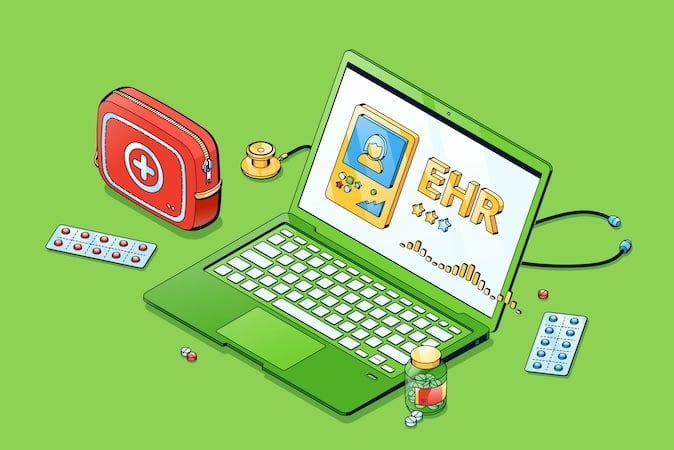
Here are the main steps of implementing an EHR:
- Set Clear Goals and Objectives
- Assemble the Right Team
- Establish a Budget and Timeline
- Gather and Define EHR Requirements
- Select and Demo EHRs
- Narrow Down to One EHR and Start Implementing
- Migrate Data
- Test EHR
- Conduct Comprehensive Staff Training
- Roll Out Your EHR
- Evaluate Success Metrics and User Satisfaction
Now let’s briefly go through each step of EHR implementation.
Step 1: Set Clear Goals and Objectives
Before you dive headfirst into the process, it’s vital to establish clear, measurable goals for your EHR implementation. Ask yourself: what exactly do we hope to achieve with this new system? What are the key metrics we’ll use to evaluate its success?
Some common goals for successful EHR implementation strategies include:
- cost optimization through task automation and delegation of provider tasks to other personnel
- increased revenue by being able to see more patients
- maintain Medicaid and Medicare reimbursements by using a certified EHR
By clearly defining these goals, you can better understand what features and functionalities you’ll need from your EHR system.
Step 2: Assemble the Right Team
Identifying the resources needed for successful EHR implementation is a critical step. First of all, because EHR implementation is not a one-person job. It requires a cross-functional team to ensure success. Consider including:
- A representative from healthcare providers or nurses who are familiar with the existing workflow and can provide valuable insight into what they need from an EHR system
- Major stakeholders from other departments, such as billing, who will also use the EHR
- A project manager with experience in electronic health record implementation to execute overall high-level project management and keep everything on track
Read more on EHR in medical billing in our blog
Additionally, don’t forget to hire a dedicated team of experts, including developers, integration specialists, and testers. This team will be responsible for setting up and customizing your chosen EHR system.
In light of the complexities involved in EHR implementation, it’s crucial to heed expert recommendations and best practices, ensuring a streamlined and efficient process. A well-defined ehr implementation plan example often includes assigning clear roles for onboarding leads, identifying external consultancy partners, and ensuring internal stakeholders collaborate effectively across departments within health organizations.
Step 3: Establish a Budget and Timeline
Next up is setting the boundaries for your budget and timeline. At this point, it’s clear that we can only come up with a rough budget since we haven’t done any research yet.
Now, this isn’t set in stone, but it provides a guideline—”we have X amount to spend, and our deadline is Y.” This top-down approach helps manage expectations when choosing an EHR and getting quotes from EHR vendors.
Step 4: Gather and Define EHR Requirements
Then, it’s time for some brainstorming. Gather your team and start defining the EHR implementation requirements. Consider the workflows, user roles, hardware inventory, and network requirements, and keep HIPAA compliance at the top of your priority list.
These requirements play a critical role in assessing the effort needed for electronic medical records implementation. They contribute significantly to the overall evaluation of our efforts.
To ensure the system supports clinician workflow and delivers value, consider referring to EHR implementation best practices gathered from other providers, hospitals, and digital health consultancies.
Step 5: Select and Demo EHRs
After you’ve gathered your requirements, let your team pick out a few EHRs that fit the bill and demo them. It’s vital to have hands-on experience to understand if all necessary scenarios are supported and meet providers’ needs or if there are possible adjustments to make to your existing workflow without causing too much disruption.
Also, consider how AI in EHR features might influence your team’s decision-making during vendor demos.
Step 6: Narrow Down to One EHR and Start Implementing
When the preliminary planning phase is over, your dedicated team starts setting up the chosen EHR while your project manager coordinates and monitors the process. Stakeholders may intervene occasionally for brief testing and feedback.
At this point, many organizations benefit from having a clear EHR implementation project plan that includes assessment checkpoints and change management guidance to stay on track through the deployment phase.
Also, before implementing a new EHR, there is one small aspect that should be taken into consideration:
At this juncture, you have the opportunity to refine your project budget and timeline. With the insights gleaned from the research conducted by your implementation team, you can now make more accurate estimations. Given the complexities of EMR software implementation, it’s very likely that your initial estimates may need some tweaking. Whether it’s:
- the labor cost for your dedicated team
- the price of the chosen EHR system
- the time required for customization and testing
All these factors should be taken into account to prepare a more realistic budget and timeline. Creating a realistic timeline for hospitals is essential in EHR implementation. This timeline should account for all stages, from planning and data migration to testing and post-implementation evaluation.
Step 7: Migrate Data
Data migration, though technically part of the entire EMR/EHR implementation process, is often singled out due to its paramount significance. This stage involves the transfer of existing patient records, clinical data, billing information, and other pertinent documents from your previous system to your new EHR platform.
It’s important to note that this process requires meticulous planning and execution, as any errors or omissions can lead to significant clinical and administrative complications down the line. In fact, having a data migration expert on your team is recommended to ensure this process is handled with the necessary care and attention. The goal is to make the transition as seamless as possible, minimizing downtime and maintaining the integrity and accessibility of your data.
A well-documented electronic health records implementation process is critical here, especially for physicians handling sensitive clinical data. It can also serve as a manual reference during audits or troubleshooting.
Step 8: Test EHR
The testing phase of the EMR implementation plan is absolutely critical and is typically performed in two steps. Initially, the development team plays a crucial role in debugging the system, ensuring it meets all the specified requirements, and operates as intended. This is where any technical glitches are identified and remedied.
But the evaluation doesn’t stop there. The next crucial players in the testing phase are your actual providers, often referred to as super users. These are the individuals who will be using the EHR system on a daily basis, and they bring a unique, practical perspective to the testing process. Their hands-on experience with patient care processes allows them to thoroughly assess the system’s usability and efficiency.
These users are known as super users because they have access to all features, giving them the power to verify the implemented EHR thoroughly. With their expertise and comprehensive understanding, they play a crucial role in ensuring the effectiveness and functionality of the system.
Remember, implementing an EHR system isn’t just about compliance—it’s about aligning with your clinicians’ real-world workflows, medicine-specific data needs, and daily usability milestones.
Step 9: Conduct Comprehensive Staff Training
You’ve come this far in your EMR implementation project, and now it’s time to ensure that your personnel are fully equipped to use the new system. Here’s where your super users come in. Given their comprehensive knowledge and firsthand experience with the EHR, they can act as peer trainers, making the learning process smoother and more efficient.
Step 10: Roll Out Your EHR
When it comes to finally releasing your EHR into the wild, different clinics and hospitals have different preferences. Some prefer a gradual rollout, while others opt for an all-at-once approach. Each method has its unique benefits and potential drawbacks and should be accounted for when working on the business plan for the implementation of EHR.
Step 11: Evaluate Success Metrics and User Satisfaction
Now that your EHR is live, it’s crucial to keep a close eye on its performance metrics. These metrics could include:
- system uptime
- speed
- ease of use
- error rates, etc.
Remember, the ultimate goal is to enhance productivity, so the system should be making tasks faster and easier, not creating new hurdles. Regularly checking these metrics will let you know if any adjustments need to be made.
But technical performance is just one side of the coin. You also need to gauge provider/patient satisfaction. Are the providers comfortable using the system? Do patients find it easy to access their health records? Is the administration able to carry out their tasks more efficiently? Gathering feedback can provide valuable insights into how well the system is meeting its users’ needs. You can collect this information through surveys, feedback forms, or even one-on-one interviews.
Anything else on the list?
The EHR implementation steps outlined above provide a broad overview of an EMR implementation project. However, they don’t address the specifics of your unique situation or particular use case.
The reality is that every healthcare institution has its own unique set of challenges, needs, and goals. There is no one-size-fits-all approach when implementing an EHR. This realization underscores the importance of customizing the implementation process to your specific circumstances, thereby avoiding the pitfalls of a generic, overly simplified plan. Your project plan might have slightly different stages of EHR implementation.
So, let’s delve deeper into certain sections, examining them through a more specific lens to help you fully grasp the intricacies involved.
Choosing the Right EHR System
Selecting the right EHR system is perhaps one of the most critical decisions you’ll make as you move along the EMR implementation steps. This choice not only shapes the scope of your project but can also significantly influence its budget and timeline. So, this is not a decision to be taken lightly. Instead, it requires thorough research, thoughtful deliberation, and careful planning.
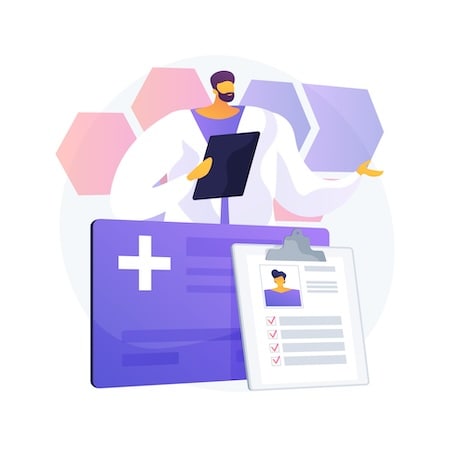
When choosing your EHR platform, consider not only its features and capabilities but also its overall usability, scalability, and compatibility with your existing systems. It’s paramount to find a solution that aligns with your current workflows and processes, yet is flexible enough to adapt to future technological advancements and regulatory changes.
If you’re working on hybrid care delivery, don’t miss our guide to telehealth EHR integration, which can make or break remote care workflows.
Criteria for Choosing an EHR Software
Here are a few key points to consider when evaluating potential EHR systems:
- Usability: A user-friendly interface and intuitive navigation are key to ensuring that your staff can quickly get up to speed with the new system.
- Functionality: The selected EHR system should be able to perform the necessary clinical operations effectively, such as maintaining patient records, tracking patient progress over time, and generating health reports. It may need to support electronic prescriptions, patient education, billing, CDSS, drug interaction checks, and various other functions.
- Customizability: The ability to tailor the system to your specific needs can greatly enhance its effectiveness and efficiency. Super relevant for the implementation of electronic medical records in hospitals.
- Interoperability: The ability of the EHR to communicate with other healthcare systems, such as labs or pharmacies, is crucial for seamless data exchange and coordinated care. The system should be able to seamlessly integrate with your existing IT infrastructure, minimizing the disruption to your operations during the transition period.
- Security: Protecting patient health information is of the utmost importance, so be sure to choose an EHR system that adheres to all relevant security standards and regulations, like HIPAA.
- Scalability: While your current needs may be met by a basic EHR system, it’s essential to consider how your institution will grow in the future and whether the chosen system can accommodate that growth.
- Integration: The system should be able to seamlessly integrate with your existing IT infrastructure, minimizing the disruption to your operations during the transition period.
- Support and training: To implement an electronic health record system seamlessly, look for a provider that offers comprehensive training and ongoing support to help your staff make the most of the new system.
- Certification: Clinics have the option to choose between certified or non-certified EHR systems. Certified EHRs comply with specific standards and criteria set by the Office of the National Coordinator for Health Information Technology.
- Cost-effectiveness: While the initial cost of the system is a significant factor, also consider the total cost of ownership, including ongoing maintenance and upgrade costs.
Choosing the right EHR system is a strategic decision that can significantly impact your organization’s performance and patient care. Therefore, it requires careful consideration and due diligence. Remember, the goal is not just to find a system that meets your current medical office’s needs but one that will continue to serve you effectively as your organization grows and evolves.
To explore the various factors that influence the cost of implementing EHR, head over to our detailed article on the topic.
Ready-Made vs. Custom Solutions
In today’s economic climate, the question isn’t whether you should build an entire EHR from scratch. The reality is very few organizations can afford to expend millions of dollars and dedicate one to two years to developing a custom solution. Building an EHR from the ground up and then setting it up is akin to working on an acquisition plan and looking to own an EHR company.
Curious how much Epic actually costs to implement and scale? Here’s our full breakdown on Epic EHR cost.
A custom EHR system, although designed to meet specific needs, comes with high development costs, time-consuming implementation, and risk of failure due to possible oversight of essential features or regulatory requirements. It also places the responsibility of security, EHR upgrades, and maintenance squarely on your shoulders.
We discuss how to build an electronic health records system in another blog if you’d like a peek.
No Custom-Built EHR, Huh?
On the other hand, there’s a scenario under which some custom EHR development might be beneficial: when you can get by with a headless EHR platform. A headless EHR provides back-end services—data storage, security, and compliance—while giving you the freedom to design the front-end user interface suited to your specific needs.
This approach of utilizing a headless EHR platform can be especially advantageous if you’re contemplating the introduction of a completely new workflow that necessitates a dedicated front end – a desire that could find itself at odds with the rigid UI of traditional EHRs.In that scenario, implementing a headless EHR can act as a stepping stone towards seamlessly transitioning to a highly customized EHR system.
Even if that seems to align with your needs, starting from scratch can be excessive. Instead, you have the option to implement an EHR system by using:
- proprietary solutions such as GetHealthie
- open-source systems like MedPlum
These alternatives offer the flexibility and functionality you’re seeking without the need for a complete overhaul.
This headless approach allows the healthcare facility to maintain compliance and security without sacrificing usability, efficiency, and unique workflow requirements. It is like having the best of both worlds—the power and reliability of established back-end systems with the flexibility of a custom front-end tailored to your specific needs.
But remember, even with a headless EHR, it’s crucial to have a skilled programming team on hand to ensure the smooth integration of these custom features. This way, you can strike a balance between customization of deliverables and affordability without compromising on necessary features or regulatory compliance. That’s a must on your EHR implementation roadmap.
Top Ready-Made Solutions
Let’s explore some of the leading ready-made solutions in the market that can cater to your EHR needs effectively and efficiently.
- Epic Systems: Epic is one of the most well-known EHR systems in the healthcare industry. Its comprehensive suite of applications, modules, and interoperability features make it a highly sought-after choice for large hospitals and integrated healthcare organizations.This EHR is known for its robust functionality and high degree of Epic customization.
- AthenaHealth: AthenaHealth is a cloud-based EHR system, preferred for its streamlined, user-friendly design and efficiency. It stands out with its robust billing features, making it a good fit for smaller practices, outpatient care centers, and multi-specialty clinics.
- Allscripts: Allscripts offers solutions tailored to the needs of various healthcare entities, including hospitals, small practices, and specialty clinics. It is recognized for its strong clinical decision support, prescription management, and interoperability capabilities.Read also Allscripts EHR integration on our blog.
- Cerner: A powerful, flexible, and customizable EHR system, Cerner is widely adopted by healthcare organizations of all sizes. Its robust offering includes patient engagement tools, revenue cycle management, and advanced data analytics.
- Meditech: Meditech is an affordable, fully integrated EHR system with a strong reputation in the industry. It’s trendy among midsize to large healthcare organizations for its user-friendly interface, seamless interoperability, and efficient clinical workflow design.
Related: a dedicated blog on how to integrate a health app with Epic EHR
Choosing the right ready-made solution can make electronic health records implementation a smoother, more efficient process, ensuring your healthcare organization is equipped with the tools it needs to deliver top-tier patient care.
If you’re looking to build a SMART on FHIR app, our blog provides an essential roadmap, highlighting key considerations, tools, and strategies to bring your vision to life effectively.
We also offer EHR integration services tailored to your preferred vendor, whether it’s Epic, Cerner, or Meditech.
Legal and Regulatory Considerations
When choosing an EHR, understanding the legal and regulatory landscape is crucial. In the U.S., EHRs aren’t just beneficial; they’re mandated by law. The Health Information Technology for Economic and Clinical Health (HITECH) Act outlines stages of ‘Meaningful Use’ that healthcare providers must comply with. Federal agencies like CMS monitor compliance and can impose penalties for non-compliance. Navigate these waters carefully – your choice of EHR impacts more than just your IT infrastructure, especially if you accept Medicare/Medicaid patients.
Data Migration Strategies
Migrating PHI and other documents to a new EHR is another critical step that can’t be overlooked. It isn’t enough to ensure a new EHR meets your current needs—you must also consider how it will handle importing and exporting data from your legacy system.
If you’re migrating from a senior care solution, see our notes on EHR PointClickCare Integration, which includes data mapping and sync strategies.
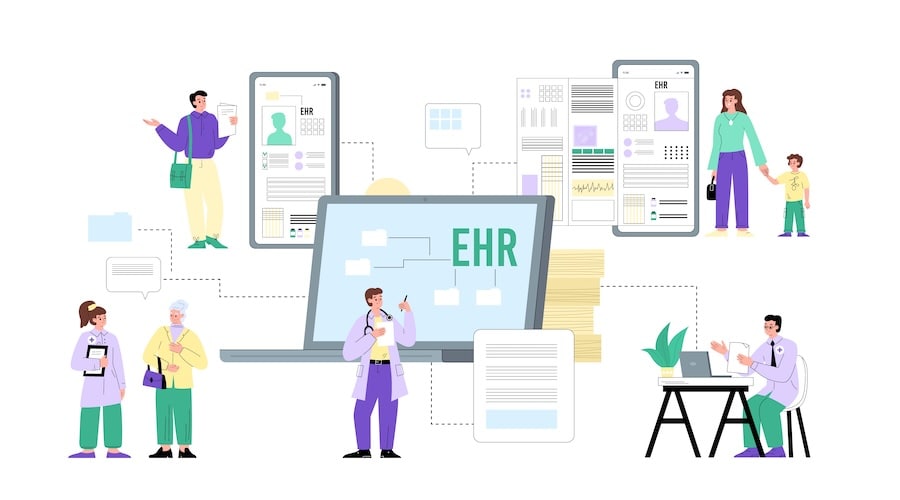 Data migration, as the name suggests, is the process of transferring data from one location or format to another. In the context of EHR system implementation, this could mean transitioning from paper records to electronic ones, which is a mammoth task involving the digitization of vast amounts of data.
Data migration, as the name suggests, is the process of transferring data from one location or format to another. In the context of EHR system implementation, this could mean transitioning from paper records to electronic ones, which is a mammoth task involving the digitization of vast amounts of data.
It could also mean upgrading from a legacy EHR system to a more current one, requiring meticulous planning to ensure data integrity and minimize operational disruptions. Similarly, there may be a need to migrate from a locally hosted EHR system to a cloud-based solution, providing valuable benefits such as remote data access, scalability, and cost efficiency. Regardless of the specific scenario, data migration is a critical step in the EHR implementation process and requires a comprehensive strategy to ensure success.
The best practices for a EHR data migration strategy should account for factors like:
- Cleanse and verify data: Ensure the accuracy and integrity of the data by removing any inconsistencies or errors, improving its quality for reliable analysis and decision-making.
- Back up data that’s ready for migration: As a precaution, always back up your data before initiating the migration process. This ensures that even in case of any unexpected issues or errors during the data transfer, you have a secure copy to fall back on.
- Set up EHR database: Establish a robust electronic health record (EHR) database system to store and manage patient information securely, facilitating efficient access and retrieval.
- Map legacy data to new EHR database fields: Develop a mapping strategy to transfer existing data from legacy systems to the new EHR database, ensuring seamless integration and preserving data continuity.
- Transfer data to the new system: Migrate the data from the legacy systems to the new EHR database, ensuring a smooth transition without any loss or corruption of critical information.
- Verify migrated data: Thoroughly validate the migrated data by eliminating duplicate entries, correcting structural errors, handling outliers, tracking missing data points, and executing quality checks to ensure data accuracy and reliability.
- Test new data inputs: Conduct comprehensive testing to validate the functionality and effectiveness of newly inputted data, ensuring its compatibility and proper integration within the EHR system.
- Set up a data recovery strategy with local/cloud hosting: Establish a robust data recovery strategy, whether through local backups or cloud hosting, to ensure data availability and protection against potential system failures or data loss.
- Set up data sync with other healthcare systems: Enable seamless data synchronization between the EHR system and other healthcare systems, such as practice management systems, to facilitate efficient data exchange and interoperability.
The technologies needed for successful EHR implementation go beyond the EHR software itself. They encompass data security measures, integration tools, and advanced analytics capabilities, to name a few.
Testing during/ post EHR Implementation
Testing is a vital stage in the EHR implementation process that ensures the system functions as intended and meets all necessary standards before full deployment.
A successful EHR deployment hinges not only on software readiness but also on thoughtful change management, a clear checklist of testing phases, and feedback loops with frontline staff.
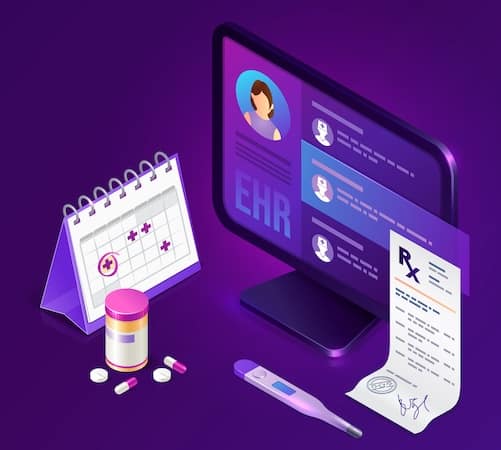
Preparing for testing involves defining the scope of the test, establishing a robust testing strategy, and creating a comprehensive test schedule. But there’s more: the testing should be conducted in a separate environment, using actual patient data but not in the production database. This approach safeguards against potential disruptions in the live setting.
There are several types of testing to consider:
- Unit Testing: This is the first level of testing where individual modules of the EHR system are tested separately to ensure each part functions correctly in isolation.
- Integration Testing: Once unit testing is completed, integration testing is performed. This involves checking how well the individual components of your EHR system work together. The goal is to identify any issues with data flow or communication between modules.
- System Testing: This is a high-level testing phase that aims to validate the system’s performance as a whole during the implementation of EMR. It’s a comprehensive examination of every function and feature to ensure the system works seamlessly when all parts are integrated.
- User Acceptance Testing (UAT): This is the final stage of testing while implementing electronic health records in hospitals, where end users test the system to ensure it meets their needs and expectations. UAT helps identify any real-world usability issues that might not have been picked up in earlier stages of testing.
First, it’s necessary to test the individual units and functionality of the system, ensuring each component works as intended. Next, workflows and data exchange between systems need to be tested guaranteeing smooth interoperability. It’s also vital to test the integrated system for overall performance and stress handling.
The testing phase should also cover infrastructural readiness, application configuration readiness, and training readiness. These aspects ensure that your organization is fully prepared to transition to the new EHR system.
Lastly, remember Murphy’s Law: “Anything that can go wrong will go wrong.” That’s why it’s essential to account for a recovery plan during the analysis phase. This plan should include redundant processors, data backup plans, and disaster recovery plans to ensure continuity of service, even in the face of unexpected system failures.
Consideration of Rollout Methods
One crucial aspect to ensure a successful EHR implementation is the thoughtful choice of a suitable rollout method. This decision plays a vital role in seamlessly integrating electronic health records, ultimately contributing to the overall success of the implementation process. So, it’s crucial to carefully consider the most effective approach to maximize efficiency and effectiveness.
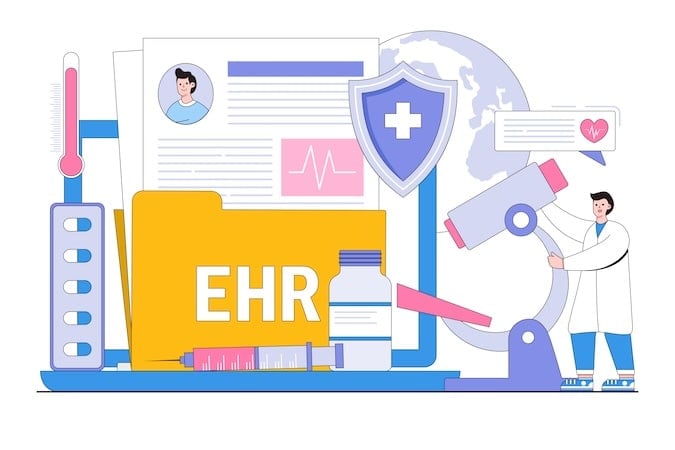
Some key factors to consider when determining the rollout method include:
- Size of practice: Smaller practices may benefit from a “big bang” approach, where all components of the EHR system are launched at once. This eliminates the need for dual workflows and ensures immediate system adoption.
- Project scope: Larger practices may benefit from a phased approach, where different modules or departments are implemented in stages. This allows for better management and minimizes disruption to existing workflows during the implementation of EHR in hospitals.
- End-user readiness: Consider the technical capabilities, ongoing training needs, and attitudes of end users when choosing the rollout method. A gradual implementation approach may be more suitable for practices with limited technical resources or those resistant to change.
- Timing: It’s essential to select a rollout method that aligns with your practice’s schedule and patient load. For example, implementing EHR systems during a slow period can reduce disruptions and ensure smooth integration into daily operations.
- Budget: The chosen rollout method may also depend on your budget. A “big bang” approach may require more resources upfront, while a phased approach can spread out costs over time.
As you understand, there’s no one-size-fits-all answer when it comes to choosing the suitable rollout method for your new EHR. The two big ones we discussed in the intro are phased and “big bang” approaches, but there are also variations within these categories. Some other methods to consider include parallel adoption, pilot testing, and hybrid approaches.
Both gradual rollout and all-at-once approach have their own set of advantages and potential challenges. Here’s a brief overview:
Incremental Rollout
Benefits:
- Allows time for adjustment: By tackling one department or location at a time, you allow your staff to gradually adapt to the new system without overwhelming them.
- Minimizes disruption: Should any unforeseen issues arise with the new EHR, their impact will be limited to a small area, reducing overall disruption.
Drawbacks:
- Takes longer: As you’re implementing an EMR system bit by bit, the overall process can take longer to complete.
- Can cause temporary inconsistencies: Different departments or locations may be using different systems during the transition period, causing potential confusion or miscommunication.
Immediate Rollout
Benefits:
- Faster implementation: By deploying the new EHR everywhere at once, you can significantly cut down the overall implementation time.
- Ensures consistency: With the entire organization switching to the new system at the same time, you’ll avoid the risk of having different departments using different systems.
Drawbacks:
- Can feel overwhelming: The sudden switch can be a lot for staff to handle all at once, potentially leading to initial resistance or mistakes.
- More significant impact if issues arise: If there are any teething problems with the new EHR, they’ll affect the entire organization at once.
Choosing the proper rollout method during the implementation of electronic health records depends on understanding your organization’s needs, capabilities, and risk tolerance. The key is making the choice that best supports your staff and the quality of care provided to your patients.
Also Read: A Complete Guide to Healthcare App Development
Post-Implementation Stage
Post-implementation is not so much a “step” in your EMR/EHR implementation journey as it is a set of essential procedures that you need to execute once you’ve migrated to the new system.

It’s about refining processes, addressing unexpected issues, and optimizing the system for your particular practice. At this stage, you’re focused on three key areas:
- Support and Training: Even after the system is live, continuous support and training are crucial for ensuring smooth operations and maximum user adoption. This might involve setting up a dedicated helpdesk, conducting refresher training sessions, or circulating helpful guidelines and tips among staff members.
- System Optimization: After some time with the new system, you’ll have a better idea of what works and what doesn’t. This is the perfect opportunity to make adjustments, be it tweaking workflows, updating templates, or adding new functionalities.
- Monitoring and Evaluation: Regularly monitoring system performance and user feedback will help you identify any hidden issues and assess the effectiveness of your new EHR. Is it delivering the intended benefits? Are there any unexpected challenges? Are users happy with the system? This sort of evaluation is crucial in ensuring your EHR continues to serve your practice’s needs effectively and efficiently.
Remember, the journey doesn’t end with implementing an electronic health record system. It’s an ongoing process of improvement and adaptation to ensure your EMR/EHR system truly becomes a valuable asset to your practice.
Topflight’s Expertise in EHR Implementation
At Topflight, we pride ourselves on our extensive experience and proven success in EMR/EHR implementation. Our breadth of knowledge spans multiple EHR platforms, including but not limited to Cerner, Epic, Allscripts, Athena, and GetHealthie.
We’ve had the privilege of working on numerous healthcare products, each one requiring a unique approach to connect to an EHR or necessitating the setup of a comprehensive EHR platform. We don’t offer one-size-fits-all solutions; we craft strategies tailored to the specific needs and goals of each healthcare organization.
For instance, if the organization’s needs can be effectively met by developing an FHIR app that seamlessly integrates within an existing EHR, then that’s precisely what we propose. We understand that sometimes, it’s about enhancing what’s already there rather than replacing it altogether. We could also consider a headless EHR path, which is proving to be highly effective for many healthcare providers.
Our extensive portfolio of successful EMR implementation and integration projects stands as a testament to our expertise in this domain. Interested in learning more? Reach out to us to get a presentation deck showcasing our ventures in EHR implementation and integration.
Check out our EHR integration services
[This blog was originally published on 12/5/2023 but has been updated with more recent data]
Frequently Asked Questions
How to implement a new EHR system?
Start by setting clear goals, assembling a cross-functional team, defining requirements, and choosing the right vendor. Then move through planning, data migration, testing, staff training, and phased rollout.
What is EHR implementation?
EHR implementation is the process of selecting, setting up, testing, and adopting an electronic health records system across a healthcare organization.
How long does it take to implement an EHR system?
On average, implementing an EHR system takes 6 to 12 months depending on the size of the organization, system complexity, and whether it’s a phased or full rollout.
What are the key steps in EHR Implementation?
The key steps in EHR implementation include setting clear goals and objectives, assembling the right team, establishing a budget and timeline, defining EHR requirements, selecting and demoing EHRs, migrating data, testing the EHR, conducting comprehensive staff training, rolling out the EHR, and evaluating success metrics and user satisfaction.
How do I choose the right EHR system for my healthcare institution?
When choosing an EHR system, consider factors such as functionality, customizability, interoperability, security, scalability, integration, support and training, certification, and cost-effectiveness. Also, consider whether ready-made or custom solutions would be more suitable for your specific needs.
What should I consider when planning data migration while implementing an EMR system?
When planning for data migration, ensure the accuracy and integrity of the data, back up data that’s ready for migration, set up an EHR database, map legacy data to new EHR database fields, transfer data to the new system, verify migrated data, test new data inputs, set up a data recovery strategy with local/cloud hosting, and set up data sync with other healthcare systems.